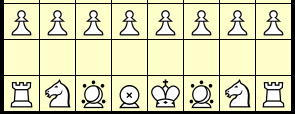[ List Earliest Comments Only For Pages | Games | Rated Pages | Rated Games | Subjects of Discussion ]
Comments by JamesSpratt
Hi, Jonathan: Thanks for the excellent rating and for your very kind comments. Your astute observation regarding the difficulty of establishing representative moves for rooks and bishops on the triangular boards brought to me an inspiration I should have had earlier, which is to color-bind the Bishops, thereby restoring them to their normal level of power in the heirarchy. All they'd need is a slightly different starting position, on opposite color cells. Anyone who wished could play it that way, and thanks again.
Hi, Jonathan, and thanks again. It's not necessary to create a perfect 3-player analog for fide chess, but now you've got me stirred to perfect what you say is the best try yet (thanks again), so I might try Chess for Three with the Bishops color-bound, knowing that that is more correct. Bishops in fide can only access half the cells on the board, anyway, and the same would be true in CF3. I'm wondering how or why I overlooked that. As the rules are written up to now, with Bishops un-colorbound, they can both move as freely to any cell as the Rooks, and seem even more dangerous than rooks because of the particular geometry of the board's triangular cells--the bishops exit the points of the triangles, they are able to slip between even quite a few pieces that appear visually to have the way blocked, parked side-by-side, but don't really stop the bishop, making him seem almost like a stealth piece, and quite sneaky. Color-binding him would put a sufficient limit on his freedom to make a better analog to his stature in fide chess. Your ASCII diagram, if you mean a move from cell A to cell C, depicts a Rook move, not a Bishop move, but I appreciate that you've studied it with some care. I've field-tested my version of Chess for Three with a hard set in public with many strangers and found that, if they could play normal chess previously, they catch it almost immediately and it's a lot of fun. If anyone cares to try it, a board requires not much geometry to fabricate from a piece of poster-board or masonite and the pieces are commonly available, being standard; just spray-paint a third set of pieces and you're ready to go. Some highschool in the UAE asked me about purchasing ten sets; I couldn't see charging a school the price for ten collector-sets, so I told them how to go about making them up for their class and that it was okay to print out the rules. Haven't heard back how it went over.
2 comments displayed
Permalink to the exact comments currently displayed.
